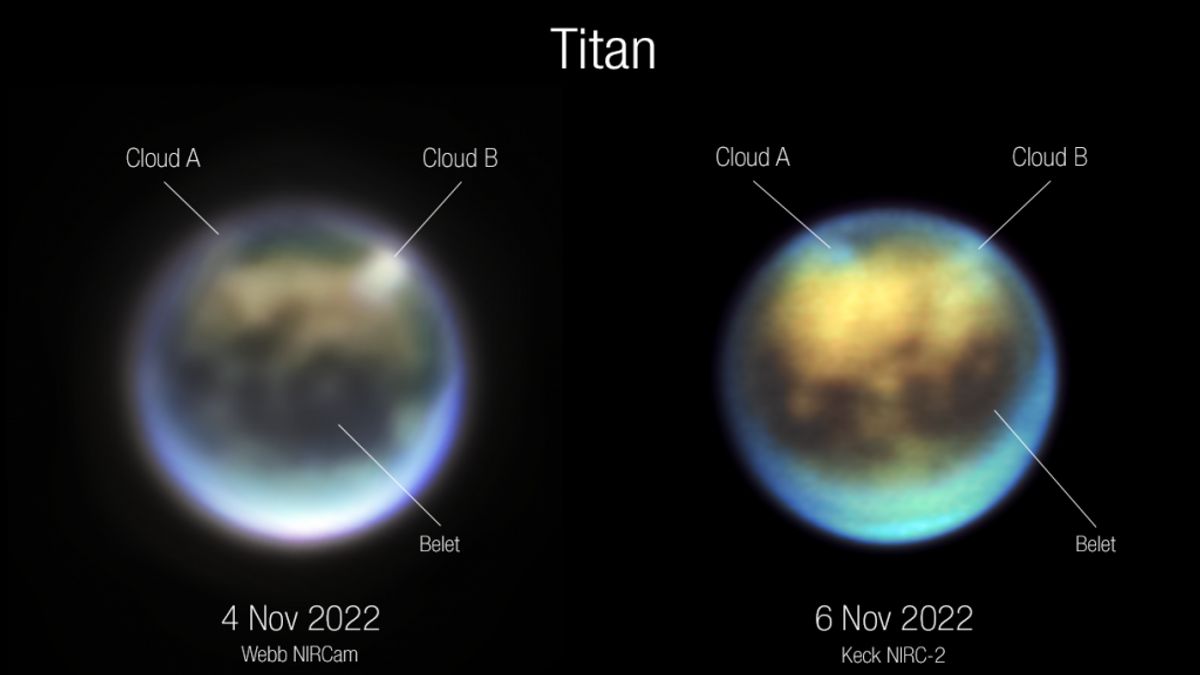JAKARTA - The James Webb Space Telescope has long been spying on one of the most interesting Moons in the Solar System, Titan, which is owned by Planet Saturn. Now, the telescope has managed to detect quite bright clouds from Titan.
In November, the giant observatory shifted the Near-Infrared Camera (NIRCam) instrument to Titan. This is the only Moon in the Solar System that has a solid atmosphere, four times denser than Earth.
Titan's atmosphere is made of nitrogen and methane, which makes it look fuzzy and orange. This thick fog obscures the visible light from the reflection of the lunar surface, making it difficult to distinguish.
Based on Webb's Space Telescope and the ground-based WM Keck Observatory, researchers can see how the clouds change.
Data in the NIRCam Webb Telescope on November 5 showed bright clouds in Titan's northern hemisphere and second cloud detection in the atmosphere. Meanwhile, WM Keck Observatory, provided confirmation images also within the near-infrared two days later.
"We were worried that the clouds would disappear when we saw Titan one and two days later with Keck, but we were happy because there were clouds in the same position, it looks like they may have changed shape," said Keck Imke de Pater researcher in a statement.
The larger cloud is located above Titan's north polar region near Kraken Mare, the largest liquid methane ocean known on the lunar surface.
Titan has Earth-like liquid objects on its surface, but its rivers, lakes, and seas are made of liquid ethana and methane, which form clouds and cause rain from the sky. Researchers also believe Titan has an internal liquid water ocean.
"Detecting the cloud is interesting because it validates old predictions from a computer model about Titan's climate, that clouds will form easily in the middle of the northern hemisphere during late summer when its surface is warmed by the Sun," said author Conor Nixon, a planetary expert and scientist at NASA.
Nixon is also a major investigator in the Webb Telescope observation program for Titan. Furthermore, atmospheric modeling experts helped the team determine that both telescopes had captured observations of the seasonal weather pattern on Titan.
Launching CNN International, Monday, December 5, the Webb NIRCam Telescope was also able to collect data on Titan's lower atmosphere, which land-based observatories such as Keck due to interference from Earth's atmosphere, in a variety of infrared wavelengths.
The data, which is currently still being analyzed, is able to see deeper into Titan's atmosphere and surface than the Cassini spacecraft, which orbits Saturn and its moons for 13 years.
Observations of the Webb Telescope could also reveal the cause of the bright feature at Titan's south pole. Researchers are planning more observations of Titan in June next year, which could provide additional information about the gases in its atmosphere.
The English, Chinese, Japanese, Arabic, and French versions are automatically generated by the AI. So there may still be inaccuracies in translating, please always see Indonesian as our main language. (system supported by DigitalSiber.id)













